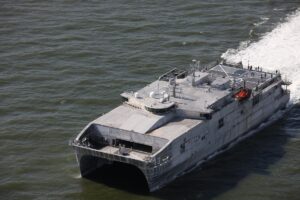Austal USA delivered the Spearhead-class Expeditionary Fast Transport USNS
Apalachicola (EPF-13) to the Navy on Feb. 16.
Delivery followed after the ship previously completed acceptance trials and Unmanned Logistics Prototype Trials in September (Defense Daily, Sept. 9).

EPF-13 differs from other ships in the class by having systems to help demonstrate some autonomous capabilities to become a self-driving platform. The company previously said its autonomy modifications include perception and autonomy control suite, automation enhancements to the machinery plant that improve the hull, mechanical and electric reliability, and reducing the amount of personnel needed for operations at sea.
“The delivery of EPF-13 comes after several successful at-sea periods for the vessel, including Unmanned Logistics Prototype Trials to assess autonomous capabilities integrated into the shipboard configuration,” Tim Roberts, Strategic and Theater Sealift Program Manager at Program Executive Office Ships, said in a statement.
In 2021, the Navy awarded Austal a $44 million contract modification in 2021 to build and demonstrate that a larger manned ship like the EPF can be delivered with some autonomous capabilities (Defense Daily, June 9, 2021).
Austal underscored the Apalachicola is the largest surface ship in the Navy with autonomous capability and by the time of delivery it has been to sea five times over several months.
The company said this has allowed it and its partners, L3Harris Technologies [LHX] and General Dynamics Mission Systems [GD], to test and analyze regular ship systems as well as those related to its autonomous design and construction contract modifications.
“Austal USA is proud to deliver this ship to our Navy – it’s innovative and is going to be a critical asset as unmanned capabilities continue to push boundaries and redefine how missions are achieved,” Austal USA President Rusty Murdaugh said in a statement.
However, Chief of Naval Operations (CNO) Adm. Mike Gilday said while the ship will be useful, it does not augur any imminent transformations in adding unmanned capabilities to other large manned ships or even planned unmanned deployments with EPF-13.
“I think one step at a time. And so in terms of that ship, it has the capability, but we will integrate it into the fleet in a very deliberate manner. And so we won’t have an unmanned deployment right off the bat, I think what you’re going to see in unmanned surface is a phasing where you’ll have minimally manned, and then unmanned,” Gilday said Thursday during the annual WEST conference, sponsored by AFCEA International and the U.S. Naval Institute
Gilday said the Navy will test out these new autonomous capabilities methodically and is not in any rush to necessarily build more autonomous-capable EPFs right away.
“One ship does not necessarily solve the command and control problems, the engineering or reliability problems. And so we’re going to want to make sure that we have it right before we move too fast, operationally, and in terms of building more of them.”
Austal noted EPF-13 will also be the first ship of its class able to conduct V-22 flight operations as well as launch and recover 11-meter Rigid Hull Inflatable Boats (RHIBs).
The company said a key part of adding autonomous capabilities to the ship is the company-designed machinery control system that allows the vessel to be minimally manned, centralizing machinery operations at the bridge.
Beyond the preexisting EPF automated hull, mechanical and electrical systems in the design that minimizes crew requirements, Austal also added automated maintenance, health monitoring, and mission readiness to Apalachicola. Austal claimed this provides EPF-13 with the ability to conduct up to 30 days of operations without human intervention.
Austal also argued the EPF’s shallow draft and high speed makes it an “ideal candidate to prototype large vessel autonomous operations, including logistics, tendering and adjunct magazine mission profiles.”
EPF-13 comes as the Navy is already developing and testing various prototype medium and large unmanned surface vessels like the Overlord and Sea Hunter/Sea Hawk USVs.
EPFs are shallow draft ships, generally designed for quick intra-theater transportation, only requiring austere ports. They are generally able to transport up to 600 short tons up to 1,200 nautical miles at an average speed of 35 knots.
EPF missions include overseas contingency operations, humanitarian assistance, disaster relief, special operations forces support, theater security cooperation and emerging joint sea-based concepts.
Austal is also under contract to build the future USNS Cody (EPF-14).